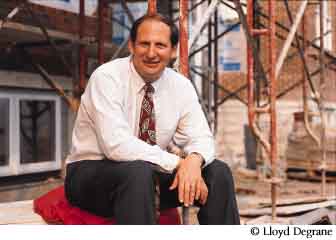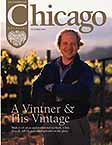The University of Chicago Magazine
October 1997

Like a good neighbor, the U of C is there
 This past July, President Hugo Sonnenschein
chose Henry Webber, associate vice president for administration, as the
University's new vice president for community affairs.
This past July, President Hugo Sonnenschein
chose Henry Webber, associate vice president for administration, as the
University's new vice president for community affairs.
Webber, who has worked at the U of C for 11 years, was already active in the Hyde Park community, from serving on the board of Hillel House to coaching a youth soccer team. A se-nior lecturer in the School of Social Service Administration, his most recent research has focused on Medicaid and health-care reform. Webber, who majored in environmental studies at Brown, earned his master's degree in public policy from Harvard's John F. Kennedy School of Government in 1984.
The Magazine sat down with Webber to discuss the University and its community-defined as Hyde Park/South Kenwood, extending from 47th Street to 61st Street and from Cottage Grove Avenue to Lake Michigan-and how the neighborhood's future fits into the revitalization occurring throughout Chicago.
What are the strengths of the Hyde Park community?
This has been, over the last 30 years, one of the most, if not the most, successful integrated, middle-to-professional-class neighborhoods in the country. The University is a major reason for that, but it's not the only reason. Another reason is that Hyde Parkers-University-affiliated and non-University-affiliated-not only live together in proximity, they live together in a community of common values. This is a neighborhood that's dedicated to values of participation, of activism, of civic involvement.
This is an enormously good place to raise children-just watch the hundreds and hundreds of kids playing soccer on the Midway every weekday. This is a neighborhood of extensive family programs that work.
It also is a neighborhood that in-cludes a set of people who are less fortunate, people whom life has treated less kindly in the past-and it's a neighborhood that cares a lot about their opportunities and how they live.
What's extraordinary, I find, is how many people are not only happy to live here but proud to live here. My wife and I have lived in Hyde Park since we moved to Chicago. Our children are 6 and 8, and they've lived here their whole lives. There is no question that this is the place that we would live if we could choose any place in Chicagoland. The idea of working at the intersection of a university I love and a neighborhood that I love is pretty nifty. I'm delighted to be doing this.
What would you say are the most pressing issues facing the community?
First, as in all urban neighborhoods, is safety. Although we do very well compared to other neighborhoods in this city and in other large cities, safety is always a concern. Second is the issue of public schools. Hyde Park is blessed with probably the finest array of schooling choices in the city of Chicago, but not all of the schools are as strong as the best of those schools. Third, strong communities require strong commercial districts. A broader array of commercial opportunities, particularly for students, is important.
How is the University addressing these concerns?
The University has been deeply committed to making this a safe neighborhood for University residents and all other residents for a long time. We provide extensive services through the U of C police force, which makes 60 to 70 percent of the arrests in the neighborhood. The South East Chicago Commission, with which we work very closely, maintains an extensive victim-assistance program. If you look back over the last 20 years, you'll see significant declines in the rates of the most serious crimes.
To improve the public schools, the University runs several programs. First is the Neighborhood Schools Program, which places U of C students in the classroom working with teachers. Our goal this year is to expand the number to 100 students, and extend the program beyond Hyde Park/South Kenwood to North Kenwood, Oakland, and further into Woodlawn.
The Office of Special Programs serves several hundred South Side students every year, counseling and preparing them for college. There is a fifth-to-eighth grade Saturday program, an Outward Bound program for high-school students, a six-week summer program for 150 elementary and high-school students, and Space Explorers, which cultivates an interest in astronomy and mathematics.
We do an extensive set of seminars in the summer for teachers in the Chicago area, and the mathematics department offers summer seminars for middle-school and high-school students, as well as teachers.
Last, but by no means least, the Center for School Improvement, which is directed by Tony Bryk, has become a major part of the renaissance that's going on in the Chicago Public Schools.
To help commercial districts in the neighborhood, we're working with the South East Chicago Commission and local businesses to market the neighborhood, to find retailers who are interested in Hyde Park, and to work with the city to improve the infrastructure. It's an important long-term effort.
How is revitalization in the larger South Side community affecting the University?
We need to be supportive of the substantial redevelopment efforts that are occurring. North Kenwood and Oakland on the north, and Woodlawn on the south, went through periods of major disinvestment in the postWorld War II period, with significant declines in population and large-scale abandonment by middle-class residents. As a result, to many individuals, Hyde Park had become isolated as a middle-to-professional-class neighborhood.
As those neighborhoods redevelop and conditions improve for residents, who want a safe environment and good housing, schools, and shopping, it allows all of us, over time, to be connected to downtown Chicago by a solid network of strong neighborhoods. Redevelopment will create a critical mass in terms of population and buying power that will allow us to support a different scale of commercial enterprise.
In addition, the redevelopment creates more opportunities for younger families and individuals to find single-family housing, something that's admittedly quite expensive in Hyde Park.
What would alumni returning to campus find the most striking change in the community?
The first thing they would notice is new construction. One thing that's been really terrific in the last ten years has been the large amount of private-sector investment in housing, primarily in townhouse development.
They will also see considerable expansion in commercial space and opportunities. The diversity of restaurants, in particular ethnic restaurants, is far broader than it was when I came to Hyde Park.
How would you characterize town-gown relations today?
Relations are very positive, although there are clearly mo-ments of tension. The University's recently established Community Service Center, which is meant to foster a culture of community service on the part of faculty, staff, and students, will continue to strengthen town-gown relations. This is a relatively small community, about 41,000 people-and the University is a large presence in the neighborhood. We are a major economic engine. There are 12,000 people employed at the University and the University of Chicago Hospitals.
We live in a world where even the largest institutions work cooperatively. You work with this community by asking questions, finding common ground, listening, and trying to reach consensus. We worked together, for example, to get the skating rink on the Mid-way. This is not a tiny thing. It's cold in Chicago in the winter; it's relatively gray. To create a public community space that's safe, that's inviting, that's well-used by students, the Hyde Park community, and residents of the surrounding communities, all in remarkable good cheer-that really helps a neighborhood.-K.S.
